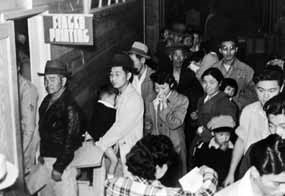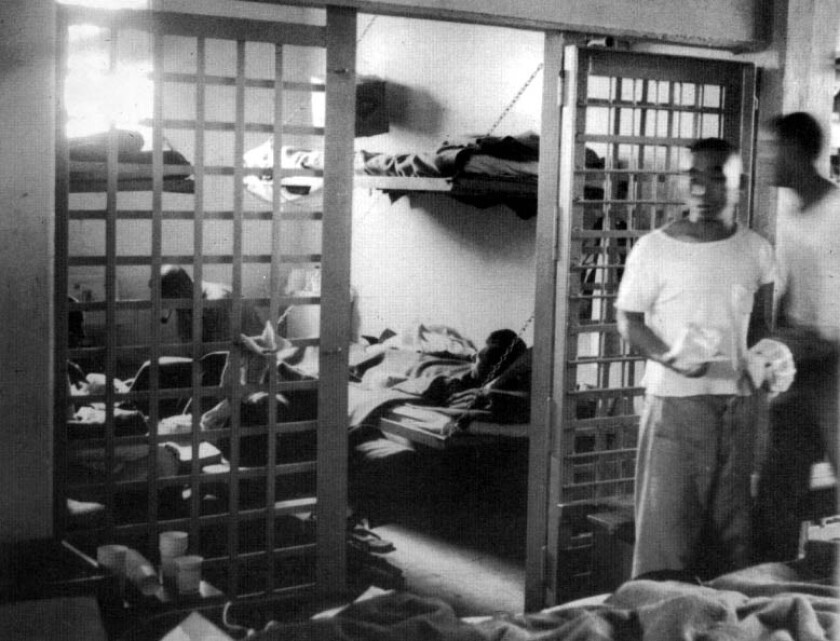
The concentration camp site was 1,110 acres; including the farmed areas, Tule Lake was 4,685 acres. It was situated on a dry lake bed created by the U.S. Bureau of Reclamation, which drained the lake in 1920 to create farming homesteads that were allocated by lottery. Today, the former camp site is under federal and private ownership.
The Tule Lake site lies within a volcanic corridor in the Cascade range; to the south of Tule Lake are the lava beds that flowed from Medicine Lake Highlands. From State Highway 139, looking west, the most prominent geologic feature on the horizon is an 800-foot bluff composed primarily of basalt. Japanese American inmates named the bluff Castle Rock; local farmers and ranchers call it the Peninsula. To the east is a dome-like hill known to the inmates as Abalone Mountain, and to the locals as Horse Collar Mountain.
The area was the ancestral home of the Modoc tribe; however, a treaty with the U.S. in 1864 led to a decade of Modoc resistance against removal from their homeland. The legendary battle of Lost River took place at the geological and historic landmark, Capt. Jack's Stronghold in Lava Beds National Monument, where a band of fifty to seventy Modoc fighters held off an army battalion whose numbers rose to nearly 1,000. After five months of resistance against army efforts to roust them from the Stronghold, the Modoc were eventually overwhelmed by army reinforcements. On October 3, 1873, the leader of the Modoc, Kintpuash, known as Captain Jack, was hanged. Surviving tribal members were exiled to Oklahoma. - Densho Encyclopedia.
The Tule Lake National Monument will bring increased understanding of the high price paid by some Americans on the home front. The Tule Lake Segregation Center National Historic Landmark and nearby Camp Tulelake in California were both used to incarcerate Japanese Americans forcibly removed from the west coast of the United States. - National Park Service

"I remember the soldiers marching us to the Army tank and I looked at their rifles and I was just terrified because I could see this long knife at the end . . . I thought I was imagining it as an adult much later . . . I thought it couldn't have been bayonets because we were just little kids." Children of the Camps. Lesson Plan
Camp Tule Lake History
Gillems Camp, one of the principal military encampments of the Modoc War of 1872-73, came to life again under very different circumstances sixty years after the army left the lava beds. The old campsite became the center of Camp Tulelake, a base for a succession of Civilian Conservation Corps (CCC) crews that would transform the newly established national monument.
The CCC was a very successful relief program during the Great Depression. In an effort to alleviate unemployment while making needed improvements to public lands, President Franklin Roosevelt’s administration started the CCC in 1933. Men enlisted for six-month tours of duty, and most re-enrolled for a full two years. Up to 150 young men were formed into work crews under Army supervision. The CCC swiftly constructed thousands of camps all over the country, including hundreds in neglected or newly established western national park sites.
Among the tasks assigned to these crews were road and trail building, firefighting, the installation of electric and telephone lines, and the construction of park administrative and visitor services buildings. For his work, a young CCC enrollee received room and board in an Army-style camp and $30 a month, of which $25 was sent home to his family. With over three million total enrollees, the CCC program contributed enormously to the economies of many impoverished hometowns.
- National Park Service

The story of the Tule Lake camp has its own resonance. It was there, beginning in 1943, that the government sent internees of Japanese descent whom it deemed “disloyal,” based primarily on their refusal to go along meekly with the government’s denial of their civil liberties. Many answered no when asked whether they would they swear allegiance to the U.S. or serve in the military. The answers for some were not simple. Would a noncitizen who swore allegiance to the U.S. be left stateless? Some sought to qualify their answer to the military question: Yes, if their families were released. At its peak the maximum-security camp at Tule Lake held 18,000 people secured by 1,200 guards (many with machine guns) monitoring fences from 28 watch towers, and backed up by eight tanks.
Like the other internment camps, Tule Lake closed down after the war. Many of the barracks were repurposed by nearby residents, and are still used on local farms or as parts of houses. But other buildings are part of what is known as the “World War II Valor in the Pacific National Monument,” a multi-site confederation of war-related locations anchored by Pearl Harbor. It is an inapt merger of sites. The U.S. actions at Pearl Harbor were undeniably valorous. What happened at Tule Lake was an embarrassment. - Los Angeles Times
Franklon Roosevelt Executive Order 9066: Resulting in the Relocation of Japanese.

My great-grandfather was a farmer.
Kaneshige Matsumoto was a Japanese immigrant and thus prohibited by California law from owning land. Instead, he worked on farms in Lodi, California, where he lived with his wife, Shizuko Matsumoto, and their three sons. Money was tight, but he set aside what he could. Before the war, he had finally started to amass some savings. - Samantha Matsumoto
Rebel Lawyer: Wayne Collins and the Defense of Japanese American Rights by Chuck Wollenberg
“Rebel Lawyer” fuels indignation at both Roosevelt and Trump. It also invites liberals to rethink the role that the American Civil Liberties Union played in the wake of Executive Order 9066. Rather than rush to the defense of Japanese Americans who were rounded up and placed in “detention centers,” the national office aligned itself with the White House. Wayne Collins defied both the president and the ACLU leadership and carved out a role for himself as a San Francisco rebel lawyer in the mold of Vincent Hallinan and Melvin Belli.- Jonah Raskin
Wayne Collins - Tule Lake Pilgrimage 2014 from Claudia Katayanagi
Curated and publshed by Jim Zellmer. Explore Tule Lake National Monument and the world in amuz. iPhone Android